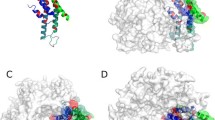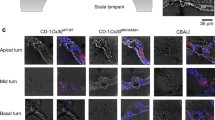Abstract
Gap-junction channels (GJCs) are formed by head-to-head association of two hemichannels (HCs, connexin hexamers). HCs and GJCs are permeable to ions and hydrophilic molecules of up to Mr ~1 kDa. Hearing impairment of genetic origin is common, and mutations of connexin 26 (Cx26) are its major cause. We recently identified two novel Cx26 mutations in hearing-impaired subjects, L10P and G109V. L10P forms functional GJCs with slightly altered voltage dependence and HCs with decrease ATP/cationic dye selectivity. G109V does not form functional GJCs, but forms functional HCs with enhanced extracellular Ca2+ sensitivity and subtle alterations in voltage dependence and ATP/cationic dye selectivity. Deafness associated with G109V could result from decreased GJCs activity, whereas deafness associated to L10P may have a more complex mechanism that involves changes in HC permeability.








Similar content being viewed by others
References
Anselmi F, Hernandez VH, Crispino G, Seydel A, Ortolano S, Roper SD, Kessaris N, Richardson W, Rickheit G, Filippov MA, Monyer H, Mammano F (2008) ATP release through connexin hemichannels and gap junction transfer of second messengers propagate Ca2+ signals across the inner ear. Proc Natl Acad Sci U S A 105:18770–18775
Apps SA, Rankin WA, Kurmis AP (2007) Connexin 26 mutations in autosomal recessive deafness disorders: a review. Int J Audiol 46:75–81
Baker NA, Sept D, Joseph S, Holst MJ, McCammon JA (2001) Electrostatics of nanosystems: application to microtubules and the ribosome. Proc Natl Acad Sci U S A 98:10037–10041
Bao X, Altenberg GA, Reuss L (2004) Mechanism of regulation of the gap junction protein connexin 43 by protein kinase C-mediated phosphorylation. Am J Physiol Cell Physiol 286:C647–C654
Bargiello TA, Tang Q, Oh S, Kwon T (2012) Voltage-dependent conformational changes in connexin channels. Biochim Biophys Acta 1818:1807–1822
Beltramello M, Piazza V, Bukauskas FF, Pozzan T, Mammano F (2005) Impaired permeability to Ins(1,4,5)P3 in a mutant connexin underlies recessive hereditary deafness. Nat Cell Biol 7:63–69
Bruzzone R, Veronesi V, Gomes D, Bicego M, Duval N, Marlin S, Petit C, D'Andrea P, White TW (2003) Loss-of-function and residual channel activity of connexin26 mutations associated with non-syndromic deafness. FEBS Lett 533:79–88
Chen J, Chen J, Zhu Y, Liang C, Zhao HB (2014) Deafness induced by connexin 26 (GJB2) deficiency is not determined by endocochlear potential (EP) reduction but is associated with cochlear developmental disorders. Biochem Biophys Res Commun 448:28–32
Chen Y, Deng Y, Bao X, Reuss L, Altenberg GA (2005) Mechanism of the defect in gap-junctional communication by expression of a connexin 26 mutant associated with dominant deafness. FASEB J 19:1516–1518
Choi SY, Lee KY, Kim HJ, Kim HK, Chang Q, Park HJ, Jeon CJ, Lin X, Bok J, Kim UK (2011) Functional evaluation of GJB2 variants in nonsyndromic hearing loss. Mol Med 17:550–556
Dalamón V, Lotersztein V, Béhèran A, Lipovsek M, Diamante F, Pallares N, Francipane L, Frechtel G, Paoli B, Mansilla E, Diamante V, Elgoyhen AB (2010) GJB2 and GJB6 genes: molecular study and identification of novel GJB2 mutations in the hearing-impaired Argentinean population. Audiol Neuro Otol 15:194–202
Figueroa VA, Retamal MA, Cea LA, Salas JD, Vargas AA, Verdugo CA, Jara O, Martínez AD, Sáez JC (2014) Extracellular gentamicin reduces the activity of connexin hemichannels and interferes with purinergic Ca(2+) signaling in HeLa cells. Front Cell Neurosci 8:265
Fiori MC, Figueroa V, Zoghbi ME, Saéz JC, Reuss L, Altenberg GA (2012) Permeation of calcium through purified connexin 26 hemichannels. J Biol Chem 287:40826–40834
Gerido DA, DeRosa AM, Richard G, White TW (2007) Aberrant hemichannel properties of Cx26 mutations causing skin disease and deafness. Am J Physiol Cell Physiol 293:C337–C345
Gómez-Hernández JM, de Miguel M, Larrosa B, González D, Barrio LC (2003) Molecular basis of calcium regulation in connexin-32 hemichannels. Proc Natl Acad Sci U S A 100:16030–16035
Gossman DG, Zhao HB (2008) Hemichannel-mediated inositol 1,4,5-trisphosphate (IP3) release in the cochlea: a novel mechanism of IP3 intercellular signaling. Cell Commun Adhes 15:305–315
Harris AL, Locke D (2009) Permeability of connexin channels. In: Harris AL, Locke D (eds) Connexins: a guide. Humana Press, New York, pp 165–206, Chapter 7
Humphrey W, Dalke A, Schulten K (1996) VMD: visual molecular dynamics. J Mol Graph 14:33–38
Johnstone BM, Patuzzi R, Syka J, Sykova E (1989) Stimulus-related potassium changes in the organ of Corti of guinea-pig. J Physiol 408:77–92
Kelley PM, Harris DJ, Comer BC, Askew JW, Fowler T, Smith SD, Kimberling WJ (1998) Novel mutations in the connexin 26 gene (GJB2) that cause autosomal recessive (DFNB1) hearing loss. Am J Hum Genet 62:792–799
Kudo T, Kure S, Ikeda K, Xia AP, Katori Y, Suzuki M, Kojima K, Ichinohe A, Suzuki Y, Aoki Y, Kobayashi T, Matsubara Y (2003) Transgenic expression of a dominant-negative connexin26 causes degeneration of the organ of Corti and non-syndromic deafness. Hum Mol Genet 12:995–1004
Kwon T, Harris AL, Rossi A, Bargiello TA (2011) Molecular dynamics simulations of the Cx26 hemichannel: evaluation of structural models with Brownian dynamics. J Gen Physiol 138:475–493
Lee JR, Derosa AM, White TW (2009) Connexin mutations causing skin disease and deafness increase hemichannel activity and cell death when expressed in Xenopus oocytes. J Investig Dermatol 129:870–878
Liang C, Zhu Y, Zong L, Lu GJ, Zhao HB (2012) Cell degeneration is not a primary cause for connexin26 (GJB2) deficiency associated hearing loss. Neurosci Lett 528:36–41
Liu W, Boström M, Kinnefors A, Rask-Andersen H (2009) Unique expression of connexins in the human cochlea. Hear Res 250:55–62
Maeda S, Nakagawa S, Suga M, Yamashita E, Oshima A, Fujiyoshi Y, Tsukihara T (2009) Structure of the connexin 26 gap junction channel at 3.5 A resolution. Nature 458:597–602
Majumder P, Crispino G, Rodriguez L, Ciubotaru CD, Anselmi F, Piazza V, Bortolozzi M, Mammano F (2010) ATP-mediated cell-cell signaling in the organ of Corti: the role of connexin channels. Purinergic Signal 6:167–187
Martínez AD, Acuña R, Figueroa V, Maripillan J, Nicholson B (2009) Gap-junction channels dysfunction in deafness and hearing loss. Antioxid Redox Signal 11:309–322
Meşe G, Richard G, White TW (2007) Gap junctions: basic structure and function. J Investig Dermatol 127:2516–2524
Nickel R, Forge A, Jagger D (2009) Connexins in the inner ear. In: Harris AL, Locke D (eds) Connexins: a guide. Humana Press, New York, pp 419–434, Chapter 20
Oh S, Verselis VK, Bargiello TA (2008) Charges dispersed over the permeation pathway determine the charge selectivity and conductance of a Cx32 chimeric hemichannel. J Physiol 586:2445–2461
Philips JC, Braun R, Wang W, Gumbart J, Tajkhorshid E, Villa E et al (2005) Scalable molecular dynamics with NAMD. J Comput Chem 26:1781–1802
Rabionet R, Zelante L, López-Bigas N, D'Agruma L, Melchionda S, Restagno G, Arbonés ML, Gasparini P, Estivill X (2000) Molecular basis of childhood deafness resulting from mutations in the GJB2 (connexin 26) gene. Hum Genet 106:40–44
Retamal MA, Evangelista-Martínez F, León-Paravic CG, Altenberg GA, Reuss L (2011) Biphasic effect of linoleic acid on connexin 46 hemichannels. Pflugers Arch 461:635–643
Retamal MA, Reyes EP, García IE, Pinto B, Martínez AD, González C (2015) Diseases associated with leaky hemichannels. Front Cell Neurosci 9:267
Retamal MA, Schalper KA, Shoji KF, Bennett MV, Sáez JC (2007) Opening of connexin 43 hemichannels is increased by lowering intracellular redox potential. Proc Natl Acad Sci U S A 104:8322–8327
Sáez JC, Schalper KA, Retamal MA, Orellana JA, Shoji KF, Bennett MV (2010) Cell membrane permeabilization via connexin hemichannels in living and dying cells. Exp Cell Res 316:2377–2389
Sanchez HA, Bienkowski R, Slavi N, Srinivas M, Verselis VK (2014) Altered inhibition of Cx26 hemichannels by pH and Zn2+ in the A40V mutation associated with keratitis-ichthyosis-deafness syndrome. J Biol Chem 289:21519–21532
Sanchez HA, Villone K, Srinivas M, Verselis VK (2013) The D50N mutation and syndromic deafness: altered Cx26 hemichannel properties caused by effects on the pore and intersubunit interactions. J Gen Physiol 142:3–22
Steel KP (1999) Perspectives: biomedicine. The benefits of recycling. Science 285:1363–1364
Stong BC, Chang Q, Ahmad S, Lin X (2006) A novel mechanism for connexin 26 mutation linked deafness: cell death caused by leaky gap junction hemichannels. Laryngoscope 116:2205–2210
Terrinoni A, Codispoti A, Serra V, Didona B, Bruno E, Nisticò R, Giustizieri M, Alessandrini M, Campione E, Melino G (2010) Connexin 26 (GJB2) mutations, causing KID Syndrome, are associated with cell death due to calcium gating deregulation. Biochem Biophys Res Commun 394:909–914
Verselis VK, Srinivas M (2008) Divalent cations regulate connexin hemichannels by modulating intrinsic voltage-dependent gating. J Gen Physiol 132:315–327
Wangemann P (2006) Supporting sensory transduction: cochlear fluid homeostasis and the endocochlear potential. J Physiol 576:11–21
Wingard JC, Zhao HB (2015) Cellular and deafness mechanisms underlying connexin mutation-induced hearing loss—a common hereditary deafness. Front Cell Neurosci 9:202
Zelante L, Gasparini P, Estivill X, Melchionda S, D'Agruma L, Govea N et al (1997) Connexin26 mutations associated with the most common form of non-syndromic neurosensory autosomal recessive deafness (DFNB1) in Mediterraneans. Hum Mol Genet 6:1605–1609
Zhao HB, Kikuchi T, Ngezahayo A, White TW (2006) Gap junctions and cochlear homeostasis. J Membr Biol 209:177–186
Zhu Y, Chen J, Liang C, Zong L, Chen J, Jones RO, Zhao HB (2015) Connexin26 (GJB2) deficiency reduces active cochlear amplification leading to late-onset hearing loss. Neuroscience 284:719–729
Zhu Y, Liang C, Chen J, Zong L, Chen GD, Zhao HB (2013) Active cochlear amplification is dependent on supporting cell gap junctions. Nat Commun 4:1786
Zoidl G, Dermietzel R (2010) Gap junctions in inherited human disease. Pflugers Arch 460:451–466
Acknowledgments
This work was supported by the Fondecyt [1120214] and Anillo [ACT 1104] to M.A.R., National Institutes of Health grants [R01 GM79629, 3R01 GM079629-03S1], and American Heart Association, Texas Affiliate Inc. Grant-in-Aid [14GRNT18750014] to G.A.A.
Author information
Authors and Affiliations
Corresponding author
Rights and permissions
About this article
Cite this article
Dalamon, V., Fiori, M.C., Figueroa, V.A. et al. Gap-junctional channel and hemichannel activity of two recently identified connexin 26 mutants associated with deafness. Pflugers Arch - Eur J Physiol 468, 909–918 (2016). https://doi.org/10.1007/s00424-016-1788-7
Received:
Revised:
Accepted:
Published:
Issue Date:
DOI: https://doi.org/10.1007/s00424-016-1788-7




